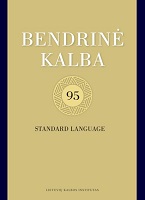Tradiciniai ir netradiciniai rytų Lietuvos oikonimai
Traditional and non-traditional oikonyms of Eastern Lithuania
Author(s): Kazimieras GaršvaSubject(s): Morphology, Sociolinguistics, Western Slavic Languages, Baltic Languages
Published by: Lietuvių Kalbos Institutas
Keywords: Eastern Lithuania; oikonyms; traditional authentic Lithuanian forms; Slavified oikonyms;
Summary/Abstract: Investigation of 3720 oikonyms in Eastern Lithuania (7455 forms in Lithuanian and Polish) shows that 98% of authentic Lithuanian oikonyms and over 60% of Slavified oikonyms have retained the features of the Lithuanian language. The influence of the Slavic languages on oikonyms began to be more pronounced here in the XVIth century, and Vilnius was the centre of slavification. Going from Daugavpils towards Vilnius, the Lithuanian elements of the Polish-written oikonyms were decreasing: in Ignalina district there were 79.1% of them, in Švenčionys district - 70.7%, in Vilnius district - 65.5%, in Vilnius - 45.5%. To the other sides of this city, the forms of Lithuanian oikonyms increased again: in Trakai district there were 69.3% of them and in Šalčininkai district 59.6%. Authentic Lithuanian forms are often recognized among Slavified oikonyms in every district. For example, in Nemenčinė (Vilnius district), Ąžuolynė was officially written in Polish Užalino, Darželiai - Doržele, Kiaūlamedžiai - Kiewlomie- dzie, Rudaūsiai - Rodowsie, Santaka - Santoka, Skersabaliai - Skiersobole, Seškūčiai - Szaszkucie, Vyžūkalnis - Wižukalnia. Lithuanian common words, dialectal Vilnius forms, compound oikonyms Juodė (Joda), Geniai (Gienie), Kvakšiai (Kwaksze), Sala (Sola); Geležiai (Gielaže), Klišabalė (Klisza Bloto), Gūdaraistis (Gudorojscie) (Maišiagala district) are also preserved here. These deformed traditional forms of oikonyms cannot be called exonyms, i. e. names of geographical objects of foreign countries. The Lithuanian proper names written in Polish letters were of 5 types: 1) fully authentic (cf. Ankšta, dialectally Unkšta - Unkszta, Dumblė, dialectally Dumbla - Dumbla, etc.); 2) partially Slavified, changing oikonymic vowels, consonants, endings, suffixes, prefixes, roots (cf. Grąžteliai, dialectally Grušteliai - Grusztele, Gruodžiai - Grodze; 3) Slavified (Mekai - Miechowo); 4) translated (Naujakiemis - Nowosiolki, Paberžė - Podbrzezie); 5) changed (Perimai - Dąbrowo) (all these oikonyms are from Paberžė in Vilnius district). When Slavifying oikonyms, Lithuanian roots, prefixes, suffixes and especially the suffix -išk-, which is especially characteristic of Eastern Lithuania, were often preserved. In South-Eastern Latvia, the suffix -išk- of oikonyms is the most common in the triangle Aknysta-Ciskodas-Sarja (Akniste-Tiskadi-Sarja). The closer the Republic of Lithuania is, the more of such oikonyms are. Now in some places there are about half of them. There are also oikonyms in Daugavpils district, the stem of which is related to the Lithuanian language: Kumpiniški ~ Kampiniškės, Lintopiški ~ Lentupiškės, Paberži ~ Paberžė, Papušina ~ Papušinė, Šlapaki ~ Šlapakiai.
Journal: Bendrinė kalba (iki 2014 metų – Kalbos kultūra)
- Issue Year: 2022
- Issue No: 95
- Page Range: 162-176
- Page Count: 15
- Language: Lithuanian

